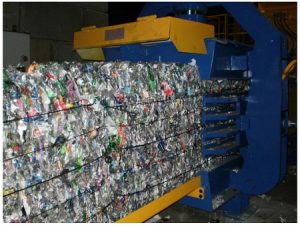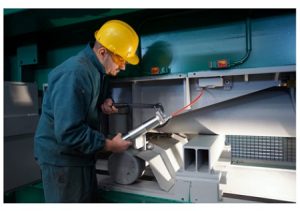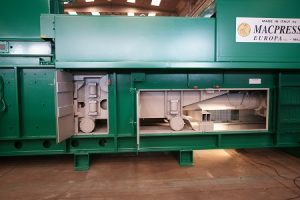Proper due diligence in evaluating the best available processing technology and baling system is imperative to a successful and profitable plant.
Richard Harris
In Europe, stringent environmental regulations coupled with limited and valuable land space have demanded creative and effective solutions to our society’s by-products and waste. These problems are also common in North America, as well as cities and countries around the world. The most effective solution is to separate and recycle all materials such as paper, plastics, ferrous and non-ferrous metals, wood and bio-waste. These discarded items can be given new life and purpose as secondary raw materials and in energy production. Technology is now available and cost-effective to use the vast majority of our current waste stream, thereby dramatically reducing the need to entomb our refuse into our precious soil. It is a worthy objective to recycle all that we can and use the remainder for making refuse-derived fuels (RDF), biodiesel, methane and electricity.
These useable by-products are commonly directed to recycling centers, materials recovery facilities (MRFs), transfer stations and landfills. A time proven technique to process the separated commodities and prepare them for shipment to paper mills, steel mills, plastic processors, and energy recovery plants is to densify these items into bales. The baled material is then easy handled, stacked, stored and shipped. There are a variety of designs and sizes in baling equipment. When considering the high volumes these collection sites generate every day there are two practical types of balers to consider: a high density, high capacity single ram baler or a two-ram baler. The final design selection will be made based on the types of materials a particular facility primarily processes and the tons per hour needed to operate.
Matching the Right Baler to the Right Task
Baling technology has advanced to meet the industry demands and the many changing materials needed to be processed—items such as plastics, HDPE, LDPE, rigid plastics, film and agricultural plastics. MSW has a wide variety of discarded items too numerous to list. This is the most difficult and unpredictable waste stream, from furniture and tires to food waste, clothing and dirty diapers. The baler must be able to constantly and efficiently provide the operator with production rates to match the demand, as well as uptime and ease of maintenance. The lowest possible cost per ton to process the waste is key to making a successful recycling or transfer station operation.
It is absolutely essential to evaluate the scope of work and match the right baler design to the task to keep the facility running smoothly. For instance, many counties and cities have decided to bale MSW to get the highest possible compaction. Great idea: however, through the bidding process many have selected a recycling baler for a solid waste application. This is a sure disaster in the making. Initially all will probably go well but the difficult, abusive items in solid waste will quickly cause maintenance problems and excessive costs when the baler design for paper recycling begins to fall apart. You can bale MSW, RDF and recyclables in a solid waste baler. You cannot bale solid waste in a baler designed for recyclables. The difference in the initial capital costs is quickly eroded in disappointing performance and maintenance costs. The idea to generate maximum density was good but needs the added due diligence to match the right baler to the task at hand.




Key Areas to Consider
Today’s baler technology offers exceptional performance to bale all types of materials. Some of the key areas of consideration should be very heavy construction, safety, ease of operation and maintenance, cost of replacement parts, baler design and flexibility of operation, lower cost per ton for labor, electricity, baling wire and producing heavy dense bales on all grades of materials.
Can your baler process all the various materials found in the recycling and waste stream well? Will the bales produced meet the mill requirements for shipping weights and bale quality? It is important to have flexibility to adjust bale lengths when processing all types of paper and plastic material. Features are available to automatically adjust bale lengths and pressure densities when switching from one product to another. Can your baler use either steel or plastic baling wire? Can you place additional wires on difficult materials easily?
Baler Safety
Safety is #1 in most facilities. Do you have all the latest technology to properly protect your employees and yourself? Do you have good service access to clean and provide preventative maintenance and routine maintenance? Safety technology on today’s balers can allow you to secure all access doors with special lock-out switches to prevent unauthorized access and limit possibly severe or fatal accidents. These special safety switches ensure the baler is turned off prior to opening protected access doors. “Lock-out/Tag-out” is the law; however, sometimes it is ignored. These safety features assist to prevent use while the baler is energized. The service person must first remove a key from the safety key box attached to the baler electrical circuit. To remove a service key, the primary key that allows the baler to be turned on must be removed and placed into that box. Then all the service keys can be removed. The service key must be used to open protected doors. The primary key cannot be removed and the baler restarted until all the safety keys are back in the box allowing the release of the primary start key.
Conveyor safety is equally important to your overall safety program. Numerous accidents occur in our industry every year involving conveyor mishaps. Safety trends in Europe and other countries are beginning to mandate use of all available safety features to protect employees from conveyor related accidents. This trend is slowly and voluntarily being used in recycling and waste handling facilities in North America. It is possible to use transponders placed in belts on all personnel working around the conveyor feeding your baler, shredder, pulper or other types of equipment. A receiving unit is placed above the conveyor so that any transponder getting within two meters automatically and immediately shuts down the equipment and sounds an audible alarm. This prevents employees from accidently falling onto the conveyor and entering into dangerous hoppers, shredders or baling equipment. Employees could have a seizure, heat stroke, heart attack or any other condition and not be able to access an emergency stop button or cable. This system protects any unconscious person. The system cannot be restarted until the employee is removed from the danger zone. Prior to entering onto the working floor, the employee passes under a scanner located above the entry door. The scanner will show green or red. Any red indicator lets the supervisor know the transponder needs replaced. A new belt is issued and the employee proceeds to work safely.
Operational Costs and Maintenance
Once you select the baler that best matches the scope of work, you need to consider ongoing operational costs. The cost of ownership is very important to the success of your facility. Does your baler require proprietary parts only available from the baler manufacturer? Can you purchase parts locally from a parts house for your electrical and hydraulic repair needs? Do you need to purchase proprietary valves or bolts made with special thread patterns only available from the baler supplier? New baler designs strive to integrate off the shelf parts so you can purchase locally if you need or prefer to do so. This will save both time and money as you go forward in daily operational use. Replaceable bolt-in wear plates also assist in reduced downtime and ensure longer equipment life.
It is most important to maintain whatever baler you select properly and regularly. This will enhance your day-to-day operations, save you unnecessary downtime and money, and improve plant safety. You can purchase the very best equipment available but it is up to you and your staff to maintain the unit with regular cleaning, lubrication and inspection. Most baler companies also provide maintenance contracts to provide preventative and routine maintenance needs should you not have in-house abilities.
Define Your Scope of Work
Proper due diligence in evaluating the best available processing technology and baling system is imperative to a successful and profitable plant. Define the scope of work well considering all the current items and volumes to be baled and look forward to what possible items might be added to your mix. Will your tonnages increase over the next five to ten years? Changes in items to be recycled are continuing to be added to the list of materials desired by plastic, paper and energy production. Just a few years ago, items considered to be out-throws or contaminates are now desirable. Do not overlook the cost of ownership, availability of spare parts and your overall cost per ton to process. Lastly, but certainly no small matter, is safety and ease of maintenance. Make sure you do your best to protect your employees with the latest safety features. We enjoy a very exciting and growing industry and the future looks bright for continued growth.
Richard L. Harris is Director of Sales for the Recycling and Solid Waste Division of Sierra International Machinery, LLC (Keller, TX). Richard is known nationwide for his skills and knowledge of the paper stock, recycling and solid waste industries. He has been designing and installing recycling systems since 1977. Richard has worked with numerous engineering firms, company owners, executives, and plant managers to develop cost effective methods to handle and process various types of recyclable materials. He has extensive experience in applying the appropriate type of equipment to perform the best results, ranging from a single piece of equipment to multi -million dollar facilities. Richard is responsible for supervising the Sierra sales team and overseeing that each project is properly designed to match the end-results our customers expect. He advocates an ongoing training program to develop each sales professional to perform to the highest possible level. He supervises all Macpresse recycling systems worldwide. Richard can be reached at (817) 337-7111, e-mail [email protected] or visit www.sierraintl.net.
